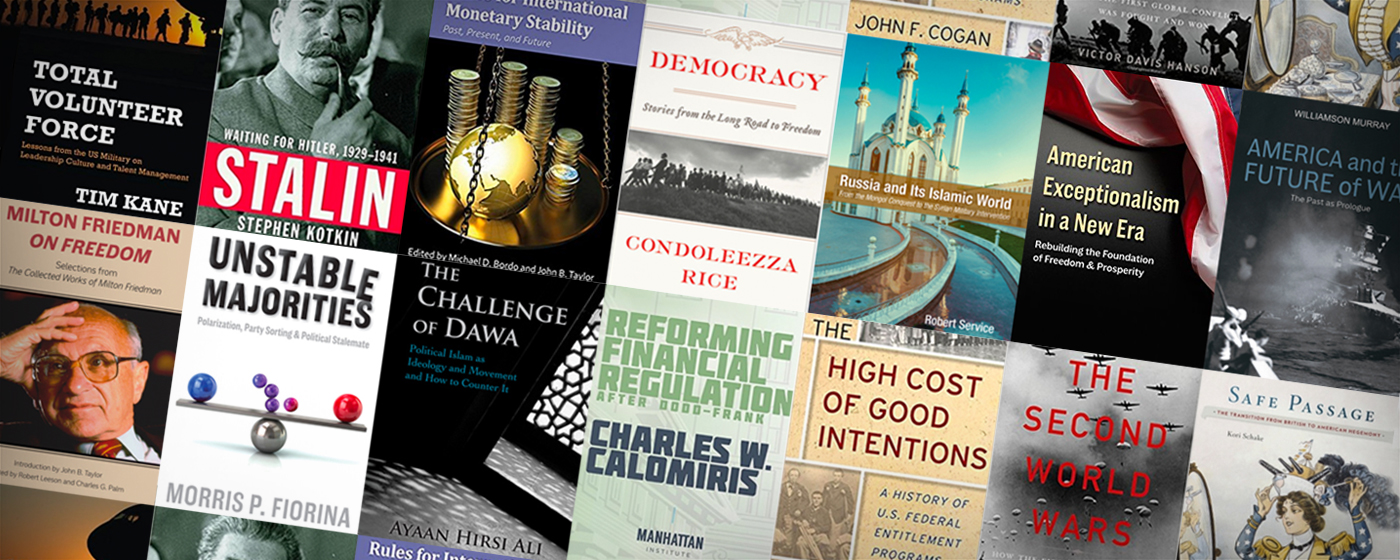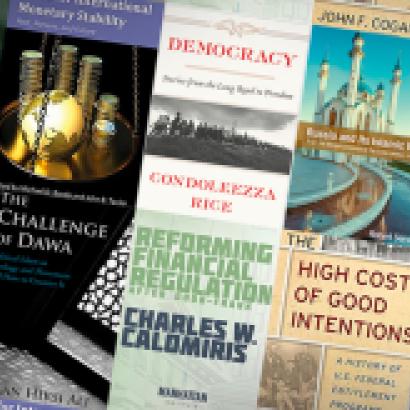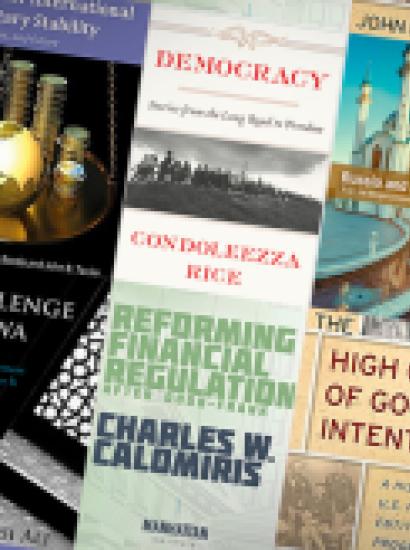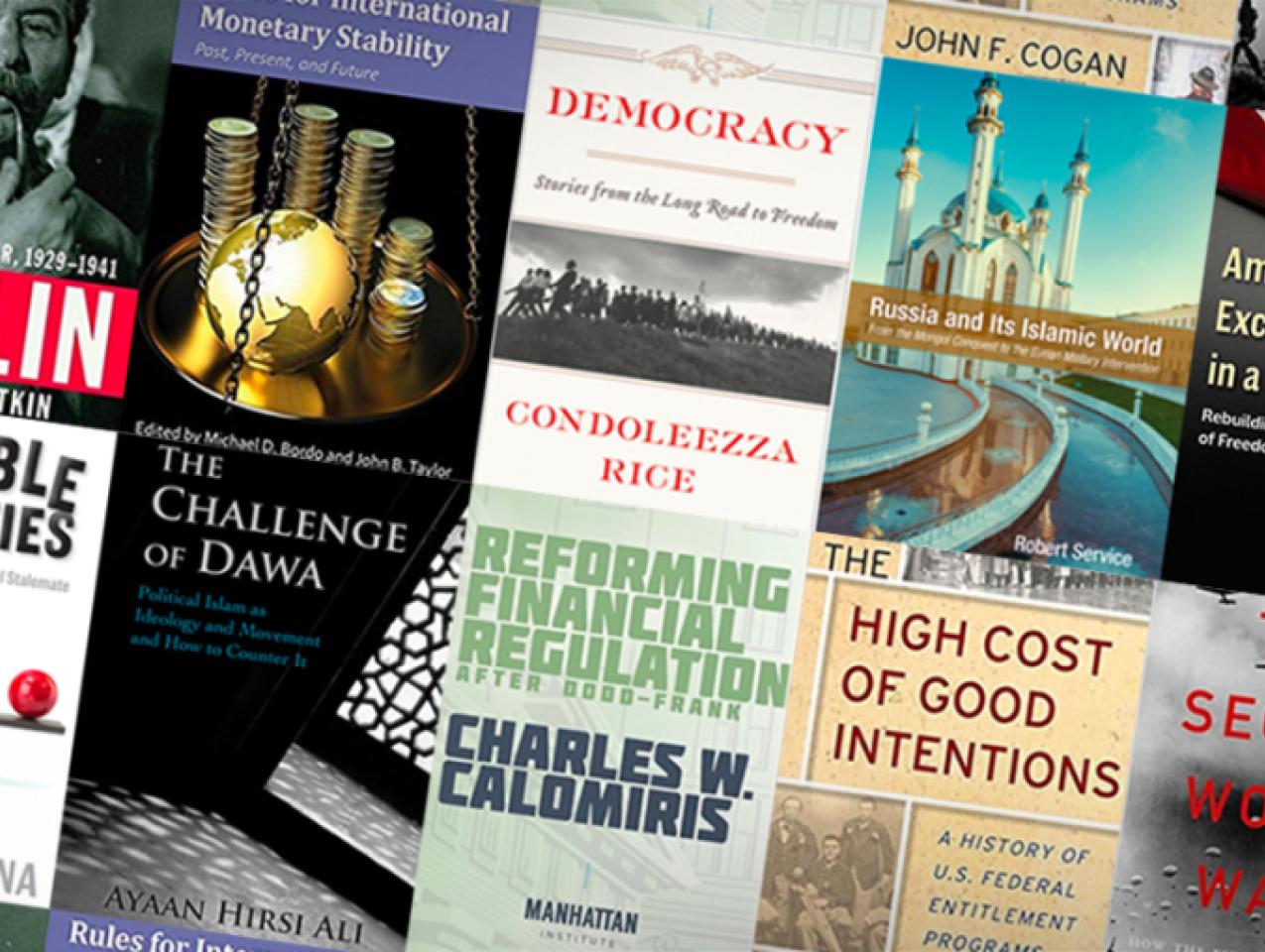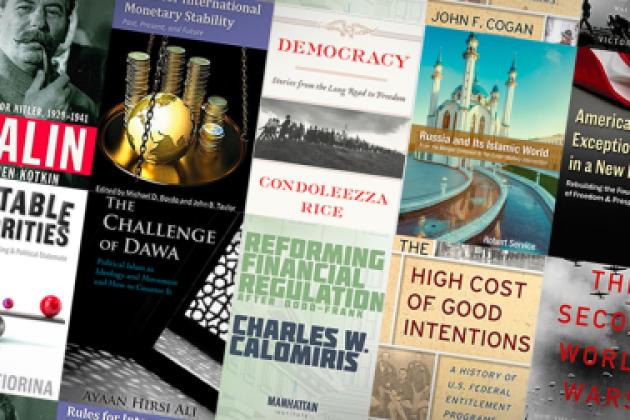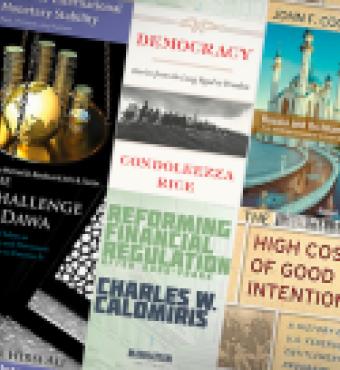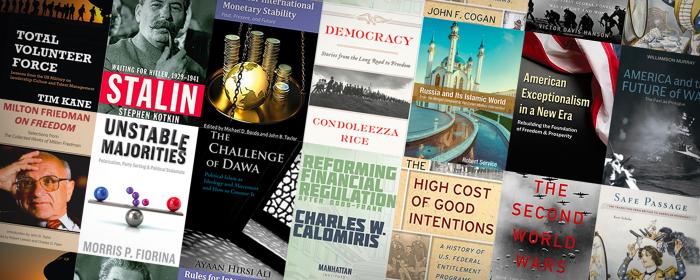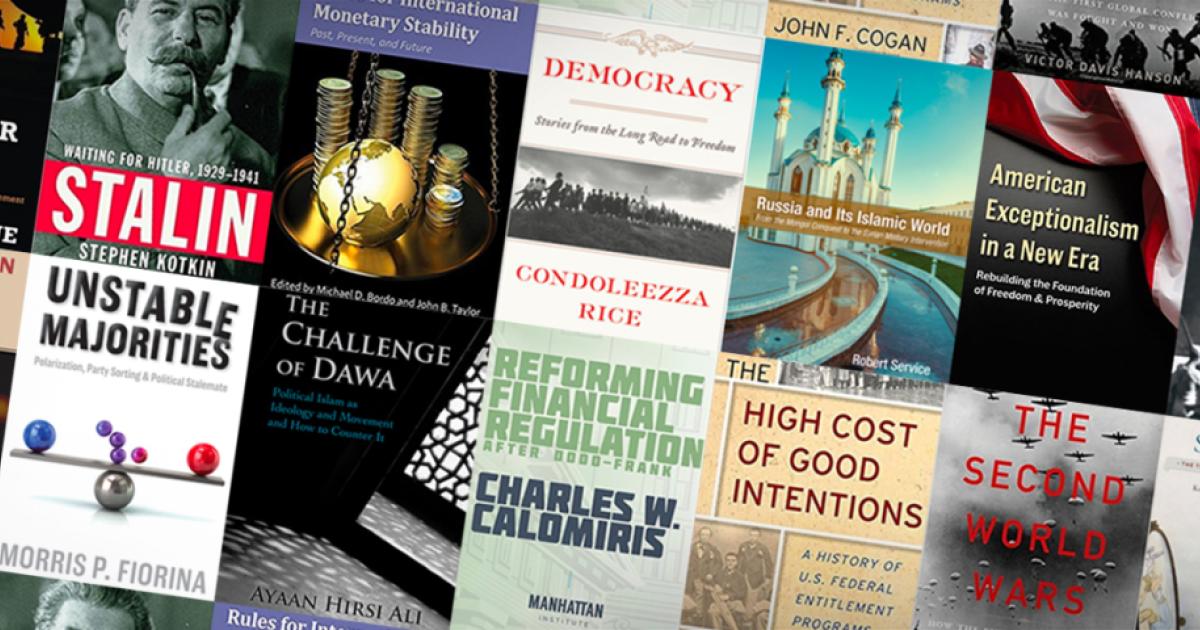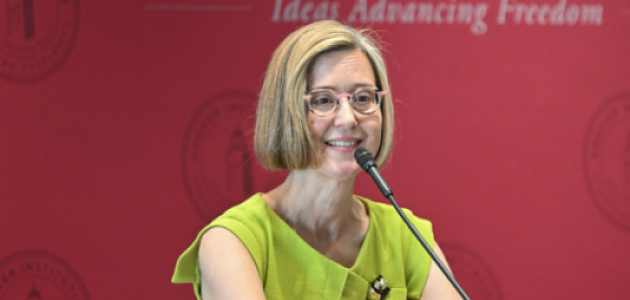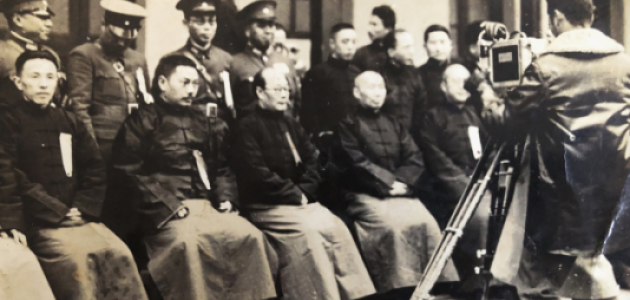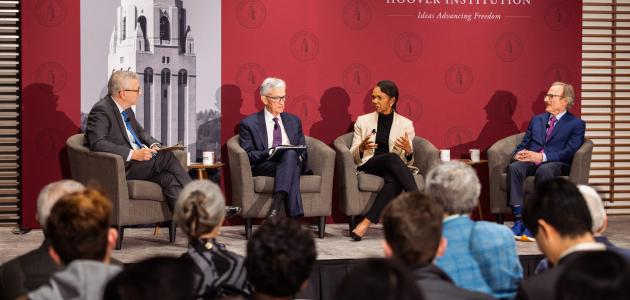The depth of Hoover’s scholarship is reflected in the numerous books published by our fellows on a broad variety of topics and issues. This timely and prodigious output offers insight on the most pressing issues in public policy. The books they published this year range in topics from democracy to World War II to financial regulation reform to the Islamic world.
Check out this selection of books published by Hoover scholars in 2017:
The Second World Wars
by Victor Davis Hanson
World War II was the most lethal conflict in human history. Never before had a war been fought on so many diverse landscapes and in so many different ways, from rocket attacks in London to jungle fighting in Burma to armor strikes in Libya.
The High Cost of Good Intentions: A History of US Federal Entitlement Programs
by John F. Cogan
Federal entitlement programs are strewn throughout the pages of US history, springing from the noble purpose of assisting people who are destitute through no fault of their own. Yet as federal entitlement programs have grown, so too have their inefficiency and their cost. Neither tax revenues nor revenues generated by the national economy have been able to keep pace with their rising growth, bringing the national debt to a record peacetime level.
Stalin: Waiting for Hitler, 1929–1941
by Stephen Kotkin
In 1929 Joseph Stalin, having already achieved dictatorial power over the vast Soviet empire, formally ordered the systematic conversion of the world’s largest peasant economy into “socialist modernity,” otherwise known as collectivization, regardless of the cost.
Democracy: Stories from the Long Road to Freedom
by Condoleezza Rice
From the end of the Cold War and the collapse of the Soviet Union to the ongoing struggle for human rights in the Middle East, Condoleezza Rice has served on the front lines of history. As a child she was an eyewitness to a third awakening of freedom when her hometown of Birmingham, Alabama, became the epicenter of the civil rights movement for black Americans.
Unstable Majorities
by Morris Fiorina
In Unstable Majorities Morris P. Fiorina confronts one of the most commonly held assumptions in contemporary American politics: that voters are now more polarized than ever. Bringing research and historical context to his discussion of the American electorate and its voting patterns, he corrects misconceptions about polarization, voter behavior, and political parties, arguing that party sorting—not polarization—is the key to understanding our current political turbulence. Today’s political parties, he shows, are more homogenous internally and more distinct from one another than previously. Voters are responders, not initiators, in the political process, able only to choose between the candidates the parties nominate and often dissatisfied with those choices.
Safe Passage: The Transition from British to American Hegemony
by Kori Schake
History records only one peaceful transition of hegemonic power: the passage from British to American dominance of the international order. What made that transition uniquely cooperative and nonviolent? Does it offer lessons to guide policy as the United States faces its own challengers to the order it has enforced since the 1940s? To answer these questions, Kori Schake explores nine points of crisis or tension between Britain and the United States, from the Monroe Doctrine in 1823 to the establishment of the unequal “special relationship” during World War II.
Milton Friedman on Freedom
by Milton Friedman with John B. Taylor
In this book, Robert Leeson and Charles Palm have assembled an amazing collection of Milton Friedman's best works on freedom. Even more amazing is that the selection represents only 1 percent of the 1,500 works by Friedman that Leeson and Palm have put online in a user-friendly format—and an even smaller percentage if you include their archive of Friedman's audio and television recordings, correspondence, and other writings.
America and the Future of War
by Williamson Murray
The end of war? History tells us not likely. Throughout the world today are obvious trouble spots that have the potential to explode into serious conflicts at anytime in the immediate or distant future. This study examines what history suggests about the future possibilities and characteristics of war and the place that thinking about conflict deserves in forming American strategy in the coming decades. The author offers a historical perspective to show that armed conflict among organized political groups has been mankind’s constant companion and that America must remain prepared to use its military power to deal with an unstable, uncertain, and fractious world.
The Challenge of Dawa: Political Islam as Ideology and Movement and How to Counter It
by Ayaan Hirsi Ali
Hoover fellow Ayaan Hirsi Ali argues that the American public urgently needs to be educated about both the ideology of political Islam and the organizational infrastructure called dawa that Islamists use to inspire, indoctrinate, recruit, finance, and mobilize those Muslims whom they win over to their cause. The purpose of this report is to suggest the basis for a new anti-dawa strategy, designed to check the advance of political Islam as an ideology and a movement.
Rules for International Monetary Stability
edited by Michael D. Bordo and John B. Taylor
The perceived negative consequences of spillovers from the actions of central banks around the world have led to increasing calls for international monetary policy coordination. Rules for International Monetary Stability reports on the results of a Hoover Institution conference that brought together academics, financial experts, and policy makers to focus on the need for a classic rules-based reform of the international monetary system.
Reforming Financial Regulation after Dodd-Frank
by Charles Calomiris
Post-2008 financial regulatory changes have largely been a failure. They have produced high compliance costs and constructed regulatory mechanisms that are unlikely to achieve their intended objectives. Furthermore financial regulation has increasingly adopted processes that are inconsistent with adherence to the rule of law, which not only threatens the fundamental norms on which are democracy is founded but also undermine the effectiveness of regulation.
Total Volunteer Force
by Tim Kane
Tim Kane identifies and examines the underlying causes of personnel dysfunction in the US armed forces and suggests specific, decentralizing reforms to Pentagon policies. His proposals aim to move personnel strategies further along the spectrum of volunteerism, emphasize greater individual agency during all stages of a US military career, and restore command authority to colonels and captains that has been missing since the centralization of the 1960s.
Hammer, Sickle, and Soil
By Jonathan Daly
In Hammer, Sickle, and Soil, Jonathan Daly tells the harrowing story of Stalin’s transformation of millions of family farms throughout the USSR into 250,000 collective farms during the period from 1929 to 1933. History’s biggest experiment in social engineering at the time and the first example of the complete conquest of the bulk of a population by its rulers, the policy was above all intended to bring to Russia Marx’s promised bright future of socialism. In the process, however, it caused widespread peasant unrest, massive relocations, and ultimately led to millions dying in the famine of 1932–33.
American Exceptionalism in a New Era
editor Thomas W. Gilligan
In American Exceptionalism in a New Era, editor Thomas W. Gilligan, director of the Hoover Institution, has compiled thirteen essays by Hoover fellows that discuss the unique factors that have set America apart from other nations and how these factors shape public policy. The authors show how America and its people have prospered and emerged as global leaders by prizing individuality and economic freedom and explore key factors in America’s success, including immigration, education, divided government, light regulation, low taxes, and social mobility. America isn’t perfect, they argue, but it is exceptional.







